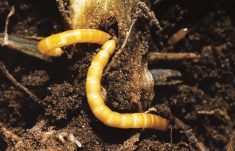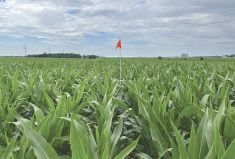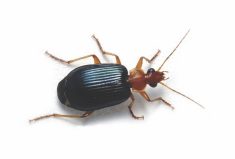Late in 2019, agronomists in mid-western Ontario urged producers to opt out of growing continuous corn or corn on corn in an effort to break the cycle of resistance that had developed within corn rootworm. The issue had arisen because of resistance to three of four Bt Cry proteins, reducing the effective modes of action in hybrids in the regions where resistance was developing.
In 2022, a new hybrid line was launched in the U.S. containing RNAi technology, not as a replacement but as a complement to existing Bt resistance proteins. SmartStax Pro, produced by Bayer CropScience, has been built off the SmartStax trait, with this latest innovation providing protection against above- and below-ground pests, and specifically corn rootworm. It’s expected growers in Canada will have access to these hybrids in 2023.
The issue with resistance to Bt Cry proteins has been well documented by numerous sources in southern Ontario for more than three years. Three of the four proteins targeting corn rootworm are closely related, with known cross- resistance between Cry3Bb1, mCry3A and eCry3.1Ab. That means a population that becomes resistant to one will exhibit some level of resistance to the other proteins, meaning cross-resistance. The only protein not cross-resistant with a Cry3 is Cry34/35. However, resistance has been documented for this protein as well. Pyramiding two or more of the Bt toxins forces corn rootworm to overcome each of the toxins at the same time.
Read Also

Sensing the soil: Root cell research finds ‘stress hormone’
Research into how root cells react to soil stressors could help plants better adapt to changes in their climate.
Most products available in Canada combine or pyramid a Cry3 with a Cry34/35, and these continue to pro- vide suitable control against corn root- worm in most situations. But in extreme cases, if one Cry toxin (Cry3 or Cry34/35) is effective against corn root- worm, then it would increase the rate at which resistance evolves to the remain- ing toxin. In most cases, neither Bt toxin is completely ineffective and how the hybrid performs will depend on what products were previously used and agronomic practices, such as crop rotation versus continuous corn.
“There’s more pressure from corn rootworm in pockets of the U.S.,” says David Kikkert, corn and soybean portfolio lead with Bayer CropScience Canada. “But we’re also seeing more of that in Eastern Canada and in areas where there is corn on corn grown, mainly for livestock producers who need that feed.”
Targeted approach
The addition of an RNAi-specific trait is unique and very different from cur- rent Bt toxins. Unlike the Bt proteins derived from a soil bacterium, this ribo-nucleic acid-derived mode of action prevents the production of a targeted, life-critical protein in corn rootworm larvae. In the absence of the protein, the larvae die. The greatest risk of resistance is associated with continuous planting of hybrids which have developed resistance to the pyramided lines. Combining RNAi with two other Bt toxins is believed to provide the best protection from corn rootworm.
“It does work differently, which is why it’s novel and unique and also a different mode of action,” says Kikkert. “That gives growers that option where they do have high pressure to combat corn rootworm. It’s also toxic to all of the instars, and that’s unique where some of the Bt proteins may have different efficacies with different instars.”
He adds that rootworm is very adaptive, so it needs to be managed proactively; it’s not just one solution. A diverse strategy with cultural or rotation plans is necessary, along with scouting, to be proactive instead of reactive.
There is also significant uncertainty as to how quickly resistance will evolve to this new trait (known as DvSnf7).
Much will depend on the efficacy provided by Bt toxins and a grower’s cropping practices. A SmartStax Pro hybrid with DvSnf7 RNA interference will provide the most robust rootworm control. But growers need to be clear that such hybrids are not silver bullets. Instead, those choosing to grow SmartStax Pro hybrids will benefit from a holistic approach to corn rootworm management, including rotation to a CRW non-host crop.
New signs of resistance
Three years ago, Huron, Perth and Bruce counties were the areas of greatest corn rootworm resistance. But Tracey Baute, field crops entomologist with the Ontario Ministry of Agriculture, Food and Rural Affairs (OMAFRA), says unexpected damage sites have also been identified in Middlesex County. They have yet to be confirmed as resistant — that takes time for bioassays. Populations were also significantly high in Bt CRW fields in Chatham-Kent and central Ontario in 2021, indicating potential signs of resistance developing.
“Although there were not a lot of new damage reports that came in, based on the corn rootworm trap network data, at least 13 sites had concerning levels of adult rootworm activity com- pared to others in the province,” says Baute. “Without intervention — that is, crop rotation and changes in manage- ment practices going forward — these sites will continue to be a problem and spread to others nearby.”
She agrees that RNAi is another tool to add for rootworm management and echoes the contention that hybrids from the SmartStax Pro lineup are meant to be paired with Bt hybrids to provide multiple modes of action against CRW to reduce the selection for resistance. But the message isn’t getting all the way to producers who may see this latest technology as a “bridge” that somehow justifies corn on corn or continuous corn production — because it isn’t.
“In the presence of Bt resistance as is the case in Ontario now, relying on RNAi hybrids as the sole management tool results in relying on one mode of action and will significantly increase the risk of resistance to RNAi,” says Baute. “We have to follow more sustainable practices — and not rely solely on transgenic corn to manage CRW — to maintain any durability of these RNAi and Bt hybrids in the future.”
It’s nice that there’s a different mode of action in these hybrids, but the presence of Bt-resistant rootworms puts more strain on the functioning trait — in this case RNAi. Corn rootworm has always found a way to develop resistance to single modes of action or single tools of management thrown at it. To keep resistance low, rootworm requires rotation of a variety of management tools.
Rotation, rotation, rotation
The most effective tool in breaking the cycle of corn rootworm resistance — regardless of the transgenic tools employed — is opting out of corn for one in every four years, though Baute acknowledges the difficulty a livestock producer may have sourcing feed. It’s one thing to say, “Try growing something else,” but it’s a different story in finding something that’s suitable for feed requirements, not to mention familiar for the farmer to produce.
“However, if they continue as status quo and resistance becomes wide- spread, they’ll lose significant yield and feed anyway,” Baute says. “Those costs will be much greater than the challenge of rotating fields.”
“We don’t know if and when new products with completely different modes of action will come. It’s in our best interest to not abuse the ones we have and try to maintain their effectiveness for as long as we can by rotating management tools and not relying solely on transgenic hybrids — in this case for CRW management.”
– This article was originally published in the September 2022 issue of Corn Guide.
















